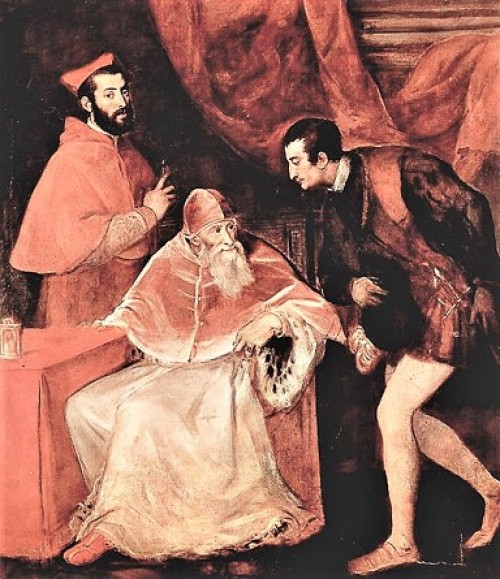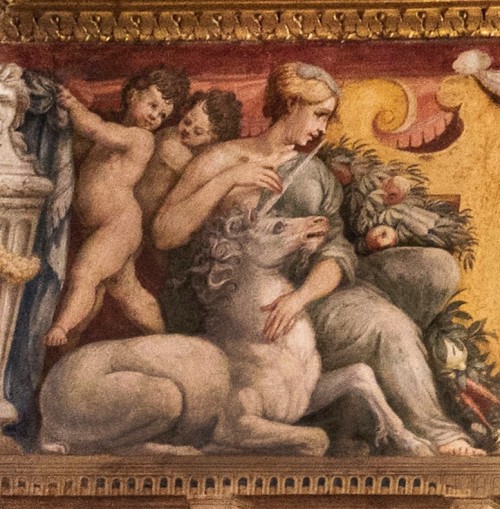
Palazzo Farnese, family residence, main façade

Pope Paul III with grandchildren (Alessandro i Ottavio Farnese), Titian, pic. WIKIPEDIA

Giulia Farnese, fragment of the fresco, Pinturicchio, private collection

Monument of Papst Paul III, Giugliemo della Porta, Church of Santa Maria in Araceoli

Bust of Pope Paul III, sacristy of the Basilica of San Pietro in Vaticano

Alleged portrait of Silvia Ruffini, Perin del Vaga, Perseus Room, Castle of the Holy Angel
It would only be a slight exaggeration to say that this family – one of the most powerful in Rome – owes its glorious beginning to a bed, which Giulia Farnese shared with Pope Alexander VI. It was thanks to her, that a low-ranking official of the Curia, Alessandro Farnese, at the age of twenty-five became cardinal. Slowly ascending the rungs of the Church ladder, at the age sixty-six he sat upon the papal throne as Paul III. Thanks to his numerous children and nepotism of unequaled proportions he created a veritable dynasty, which would rule along with him, but also long after his death, not only in Rome, but also outside its borders.
It would only be a slight exaggeration to say that this family – one of the most powerful in Rome – owes its glorious beginning to a bed, which Giulia Farnese shared with Pope Alexander VI. It was thanks to her, that a low-ranking official of the Curia, Alessandro Farnese, at the age of twenty-five became cardinal. Slowly ascending the rungs of the Church ladder, at the age sixty-six he sat upon the papal throne as Paul III. Thanks to his numerous children and nepotism of unequaled proportions he created a veritable dynasty, which would rule along with him, but also long after his death, not only in Rome, but also outside its borders.
Despite the fact that the roots of the Farnese family stretched back many years to the XI century, subsequent centuries led it to be marginalized. Similarly to the other representatives of the so-called black aristocracy (Borgia, della Rovere), it owed its sudden ascent to a pope, who took advantage of a historic moment, the appropriate marriages and the status of cardinal in order to create a truly European dynasty. Giulia Farnese, was an important piece of the puzzle, since it was thanks to her that her brother Alessandro received the valuable post of the papal treasurer, while at the time when he became cardinal – the post of treasurer of the Vatican and a papal legate, which would ensure him with a prosperous life. It was at that time that he thought of creating the appropriate palace for his family. In 1514 he entrusted works on Palazzo Farnese to significant architects (Antonio da Sangallo the Younger, Michelangelo, Giacomo della Porta). The structure was completed and outstandingly furnished more than a half a century later (1598) and nobody in the city could have doubted – it was not only a palace, but a testimony to the power of the family (today it is the residence of the French embassy). A footbridge was constructed to lead guests to the Villa Farnesina located on the opposite bank of the Tiber, an urban palace which had previously belonged to Agostino Chigi, bought by the pope’s grandson of the very same name, Alessandro Farnese, in 1579.
However, let us return for a short while to cardinal Farnese himself – the future Pope Paul III. In his youth he led a normal for those times secular life. He had a lover, Silvia Ruffini and four children to whom she gave birth and for whom he was an exemplary father. And it was in his children that the cardinal’s best hopes rested – for who is a pope without a whole court of nepots taking care of his interests? However, he had to wait a long time to ascend to the papal throne. This did not happen until 1534. His already adult at that time children, were leading a prosperous but not an extravagant life. From among the four of them the oldest was Constanza, later subsequent sons were born; Pier Luigi, Paolo and Ranuccio), only Constanza and Pier Luigi still lived. Immediately after assuming the mantle of pope Paul III began an intensive campaign, heading towards placing them, but especially his numerous grandchildren in the most important Church and secular institutions. In this way he created an almost textbook example of nepotism in its most distilled form.
Let us begin with the pope’s children:
Constanza Farnese – the pope’s favorite daughter was born, when her mother was still officially married to Giovanni Battista Crispi. She married Count Basio Sforza II and had ten children – they lived together in the Palazzo Farnese which was still under construction. All of their descendants enjoyed the pope’s great support. The male heirs were provided with benefits while the female ones were well married, populating the residences which sprung up all around Rome. These who were designated to serve the Lord, such as Constanza’s son Guido Ascanio Sforza became a cardinal at the young age of sixteen. Constanza herself, was at the side of her father one of the more influential figures in the city. The pope also gave her all authority in the city of Bolsena.
On the other hand the black sheep of the family – Pier Luigi Farnese, as soon as his father had become pope, received the honorable title of Gonfaloniere of the Church, meaning the general of the papal armies, as well as the Duchy of Castro, while in 1545 he acquired new territory – carved out of the State of the Church and created especially for him, Duchy of Parma and Piacenza. Pier Luigi suspected of numerous vile deeds of both moral and criminal nature, became infamous for being a rapist and a sodomite (homosexual), while his figure, not without reason was “condemned” to eternal damnation by Michelangelo, depicting him in his Last Judgement, as a man wrapped by a serpent devouring his genitals. Perhaps the pope’s greatest achievement was fathering Alexander (1520-1589) – a future cardinal and an outstanding patron of the arts, and in addition one of the most influential people of the then Europe. It was thanks to him that that the magnificent building of the Church of Il Gesù was created. Another, mutual foundation of the brothers – Cardinal Alexander Farnese and Cardinal Ranuccio Farnese – was the Oratory of Santissimo Crocifisso. The remaining heirs of Pier Luigi married into wealthy European families. For example Ottavio, who took over the titles of duke from his father, became the husband, of albeit born out of wedlock, but still the daughter of Emperor Charles V – Margaret of Parma. In this way the pope’s grandson found himself a member of the imperial family. On the other hand, Victoria married the duke of Urbino from the della Rovere family. Orazio Farnese (the duke of Castro) married the born out of wedlock daughter of the King of France Henry II. In this way the dynastic policy of Paul III led to an ideal balance in the relations between France and the Holy Roman Empire – both the monarchs married off their illegitimate daughters to the pope’s grandsons. We can say, that thanks to the papal grandsons a truly ideal European consensus was achieved.
However, in the XVII century the influence of the Farnese family diminished. The papal grandson, Alexander Farnese, who was predicted to one day become pope, did not achieve this goal. In the middle of the century, the Duchy of Castro was lost, while the Duchy of Parma and Piacenza was transferred from one hands to the next, becoming – over the years – the property of the Bourbons and then the Habsburgs.

The final heir of the family, Antonio Farnese, died in 1731, while his only niece married the King of Spain and Naples, Philip V. Her descendants still live in Naples to this very day.
What remains of the Farnese family? The magnificent palace in Rome (Palazzo Farnese) and the palace in Parma and Piacenza, the residences scattered throughout Latium (Gradoli, Montalto di Castro, Nep, Valentano, Viterbo) and – towering above all of them – the enormous structure in Caprarola (according to the design of Jacopo da Vignola), as well as the magnificent collections of art (ancient and modern), which can presently be seen in two Neapolitan museums – the National Archeological Museum and Museo di Capodimonte.





















